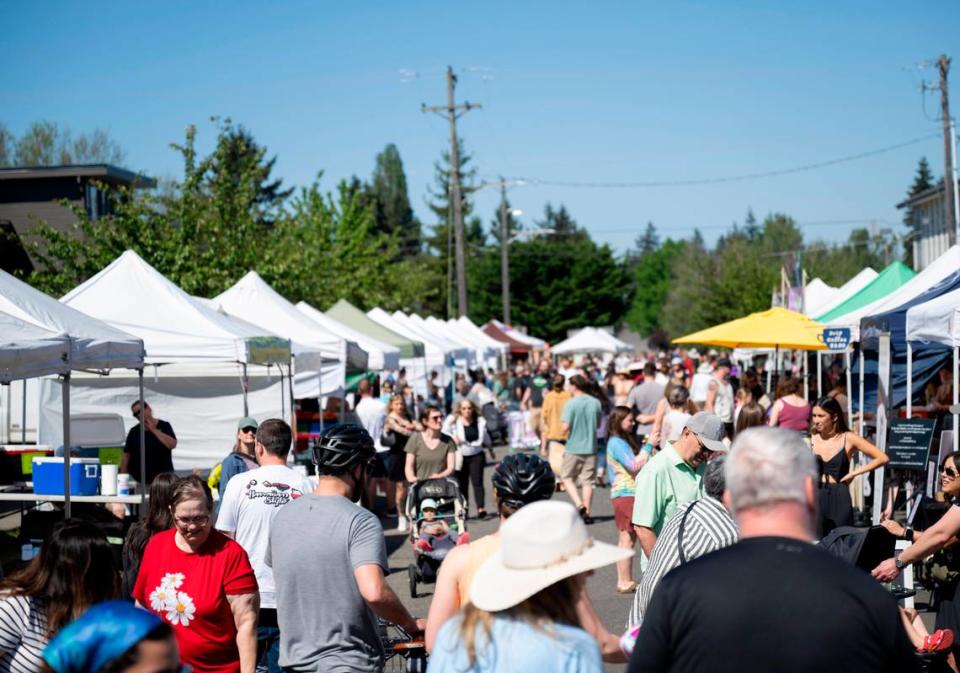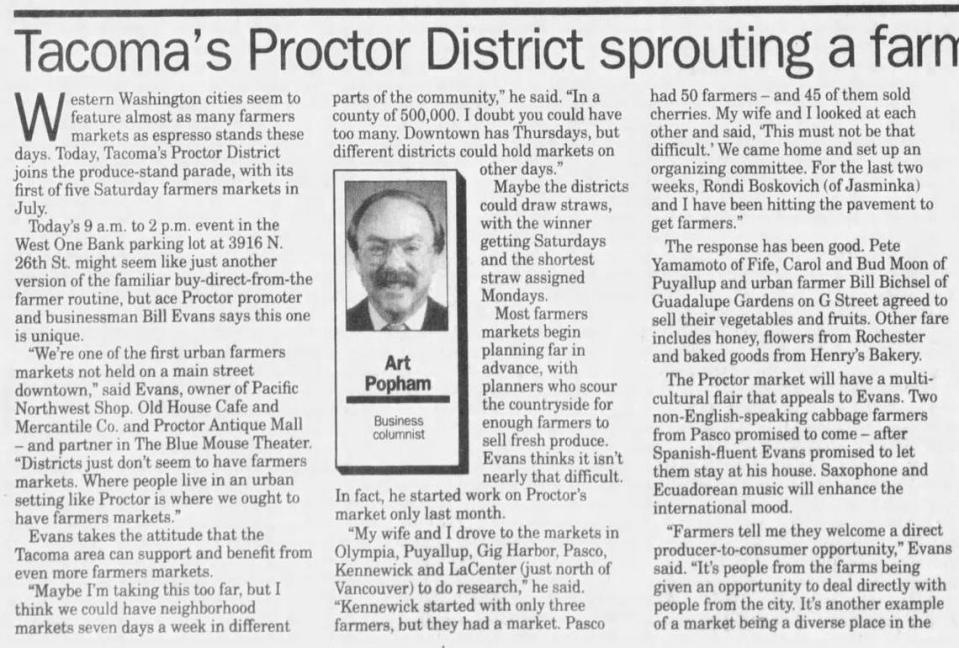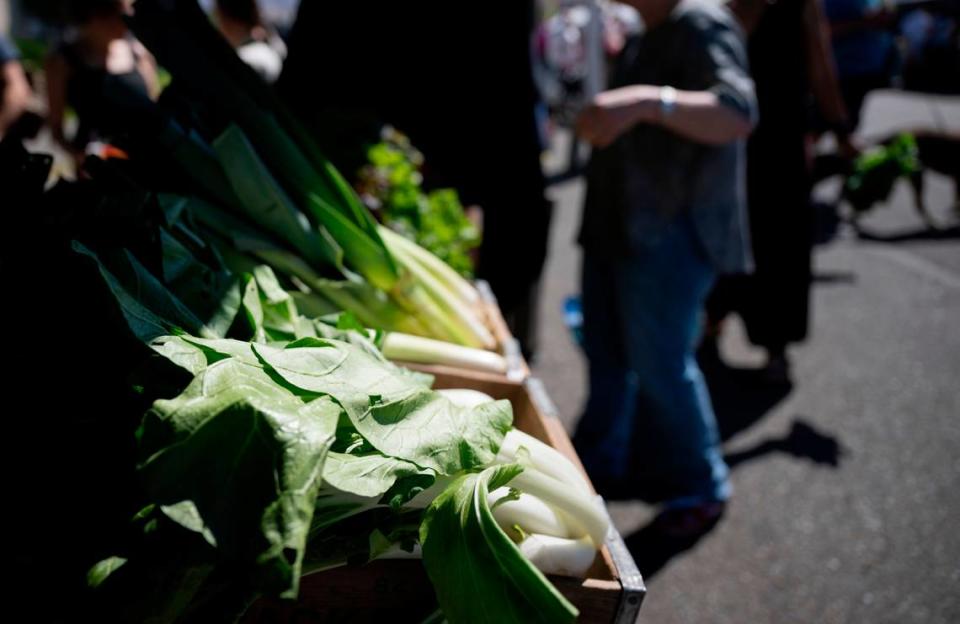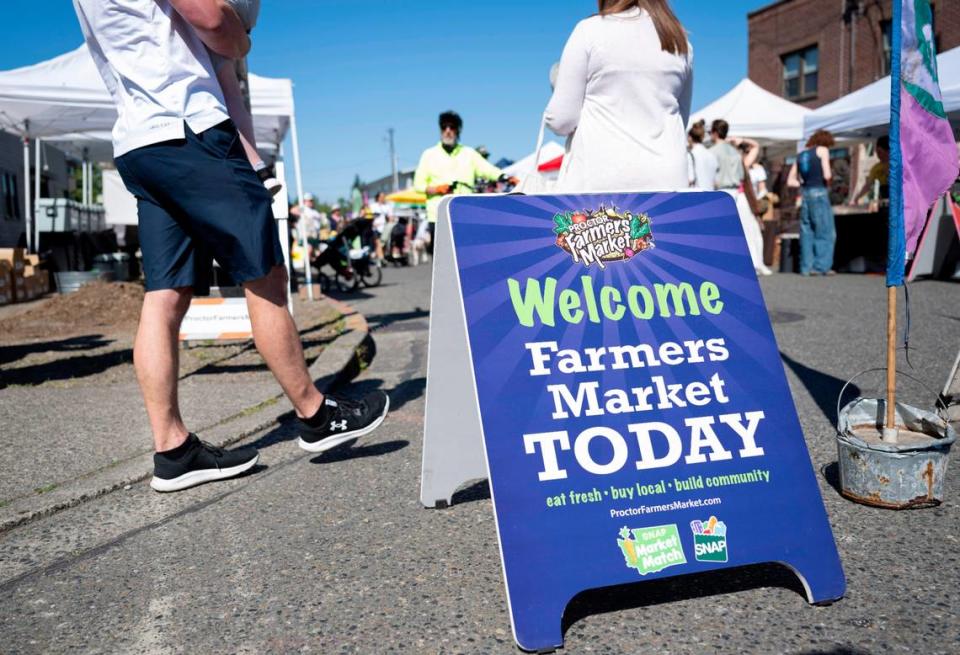From ‘Wild West’ to sales in the millions. How a Tacoma market became part of city’s soul
The produce tables weave between the hearty greens and stalky asparagus of early spring, giving way to the prized pink rhubarb that signals the incoming summer. We hold onto the bright berries and striped tomatoes in hopes of the sun lasting deep into fall and begrudgingly welcome the return of bloody beets and stiff turnips to carry us into the new year. All the while, Hmong flower growers craft colorful bouquets alongside bakers, cooks, foragers, second- and third-generation fishermen, cattle wranglers and cheesemongers with coolers under their tents.
Every Saturday, save for three monthly rounds in winter, thousands of shoppers and strollers, literal and figurative, descend upon North 27th and Madison streets for the Proctor Farmers Market, spending millions of dollars annually that land straight in the pockets of growers and food producers who live and work within 200 miles of Tacoma.
The success of the independent market, which turns 30 this summer, is as much a testament to the importance of local commerce and the power of fresh food — and maybe also a hearty loaf of sourdough or takeout box of chili-garlic noodles — as it is to the essential nature of unexpected community gathering spaces.

“All week I would look forward to the farmers market,” said Alex Starner, who became an avid customer after moving to Tacoma from Baltimore in the early 2000s and now leads the vendor committee. Find him in the crowd wearing a wide-brimmed hat (or a beanie if it’s cold), carrying multiple tote bags that look heavy because they are — he makes multiple trips back to his nearby home, especially when it’s time to restock the protein freezer.
“I have warm friendships at Proctor Farmers Market that will last a lifetime,” Starner said. “I can’t think of a single friendship that I’ve formed at Safeway or Met Market. It’s that community space that just forms every Saturday morning — that you’re gonna see friends and neighbors every week, and you’re gonna have meaningful conversations with them. For me, that was just as much of a draw as the amazing produce.”
This spring, TNT Diner spoke with several of the market’s early organizers and advocates to glean some history and understand, perhaps, how a very grassroots project became a multi-million-dollar community event.
STARTING A FARMERS MARKET
The kickoff was admittedly bare-bones: Just a handful of local people, including the late Proctor champion and Tacoma civic leader Bill Evans, asking local people to set up a table in the West One Bank parking lot (now U.S. Bank) at 3916 N. 26th St.
On July 2, 1994, this newspaper introduced the upstart market, with just five scheduled dates, as yet another leafy float in the “produce-stand parade” of the “familiar buy-direct-from-the-farmer routine.”

Insinuating that the idea was already trite, the writer miscalculated the impact a weekly food-centric street takeover would have not only on the Proctor District and the city of Tacoma but also on communities across the country. Thirty 30 years later, what were fewer than 2,000 markets now surpasses 8,700, according to the U.S. Department of Agriculture. In 2015, sales at farmers markets exceeded $1.5 billion, some of that sum funneled through federal and state funding for food-security programs, including the Supplemental Nutrition Assistance Program that largely supports seniors, children and people with disabilities. Since 2014, the Farm Bill has allocated money to match programs that help farmers markets like PFM double the value of SNAP dollars spent on fruits, vegetables and edible plants.
PFM is also one of just 1,300 or so nationwide and only a few in Washington state that operates year-round.
“Where people live in an urban setting like Proctor is where we ought to have farmers markets,” Evans, who also owned the Pacific Northwest Shop, told The News Tribune business columnist ahead of that first Saturday in 1994. “In a county of 500,000, I doubt you could have too many.”
In 2024, that population count is nearing 1 million, and farmers markets abound.
At that time, though, most markets existed in downtown cores, he said. In Washington, they included the still-prized, multi-day, year-round one in Olympia as well as seasonal affairs in Puyallup and Gig Harbor. Evans and his wife, according to the article, also took research trips to Kennewick and Pasco. Tacoma Farmers Market kicked off in 1990.
“The farmers market is one of those ingredients to make an attractive district” for locals, residents of nearby cities and tourists alike, said Erling Kuester, another of the initial organizing cohort who also worked with Evans to rescue the now-100-year-old Blue Mouse Theater. “That’s why it’s important to curate businesses … that are unique, that are relevant, that are fun and exciting. It’s a dynamic process, but it’s got to be intentional.”

FOCUS ON FOOD
Farmers markets have evolved from those down-to-earth days of the 1990s. While some have moved beyond their initial farming focus, PFM has stuck with the theme.
“That was sort of our mission: for the garden or for the kitchen,” said Valerie Foster of Zestful Gardens, a market mainstay for more than two decades. She also served on the board, formed when PFM eventually incorporated as a nonprofit, for many years. “It’s gotten a little broader, but I still think it fills that role of feeding people good, local food.”
Rotating 8 to 10 acres of crops at her 32-acre farm off River Road, which she manages with her daughter Holly, Zestful has grown along with the market.
“It’s the world of connecting the customer with the grower,” said Foster. “I feel a great deal of accountability to the customer because I know them, I know their family and I know their pets — and they know me, and they know where my farm is. I think that is a really important connection. You don’t get it from the grocery store.”
Over the years, as the “artisan” food industry and mobile restaurants took off, the market allowed vendors beyond the agricultural expectation. It morphed into a “springboard for small businesses,” noted Foster, igniting the likes of Ice Cream Social, Infinite Soups and Howdy Bagel into brick-and-mortar businesses.
Vendor diversity has evolved. Gateway to India has cooked on site for more than a decade, Jan Parker Cookery draws lines for seasonal Filipino fare, Selva Central Goods infuses Mexican and Central American flavor into delectable pastries, and Bonafide Potents incorporates Black and Korean heritage into unique potables forged with market fare, to name a few.
FROM PARKING LOT TO SEVERAL BLOCKS
Bruce Larson, an early organizer and current board member, fondly recalled managing the market, mostly as a volunteer, in the late ‘90s and early 2000s. He joined the fray as a low-key vendor, selling plants he grew in his backyard to buoy fundraisers at his son’s school.
In the first decade, he recalled, vendors earned maybe $6,000 in sales, “and we thought, ‘Oh, that’s pretty good.’ The next year, we had probably a handful more vendors, and sales just started taking off exponentially.”
Around 2000, although no one seemed sure of precise timing, the market moved to its current location on 27th and Proctor.
“Back when I started — it’s funny — it felt like the Wild West,” said Scott Gruber, current board member and owner of Calendula Farms, a native-plant nursery that started as a PFM vendor in 2003. Now it’s not unlike markets in much bigger cities; it feels “very well organized and finely tuned, for the most part.”

In his memory of those early days, the rules around what could be sold at the market were “loosey-goosey.” He laughed recalling a “guy who sold hot dogs and cans of soda.” Now, in an era of max-capacity and a very competitive application process with limited openings each year, “That would be the most heinous, cardinal sin!”
In 2009, through stall fees and other contributions, PFM reported annual revenue around $54,000, according to public tax documents. By 2016, that number surpassed $100,000 and in 2021 reached above $200,000. Direct vendor sales, meanwhile, jumped the $1 million mark some time in the mid-2010s, Larson estimated, following the transition to a year-round schedule. They have increased from there.
“It’s not that we were focused on money,” he said in April. “We wanted to make it bigger and more of an attraction.”

He remembered the havoc, years ago, that ensued the market’s decision to add a second berry grower.
The first one was “bringing all they could — the best, juiciest berries in the valley — yet it wasn’t serving the need of the market completely,” he said. The original vendor continued to sell out, while overall berry sales tripled.
“We wanted our vendors to be successful and to keep coming back,” he added. “We just didn’t indiscriminately add vendors.”
By the mid-2010s, tents spilled onto to Madison Street, eventually in either direction, toward 26th and 28th. That’s as big as it can get, noted current executive director Karen Bowes, as growth in this location would run into through-way alleys and private driveways. Instead, she said, the market can dedicate itself to “sustaining each and every vendor.”
Gruber said the board has discussed moving “many times,” but other locations just don’t make sense. “Now we’ve been there so long, it’s just a fixture. It brings in so many people. They fan out. We’re just part of the neighborhood, and we fulfill a pretty important role now.”
A busy morning can attract some 10,000 people to the Proctor District.
“There is nothing better than working hard and getting it going and having a little bit of music and neighbors coming in and talking to each other,” mused Larson this spring. “By 10 o’clock, 11, it’s bustling and really an amazing experience.”
PROCTOR FARMERS MARKET
▪ North 27th and North Proctor streets, Tacoma, proctorfarmersmarket.com
▪ Saturday, 9 a.m.-2 p.m. (weekly April-December, monthly January-March)
▪ Check instagram.com/proctorfarmersmarket for updates on 30th anniversary celebrations throughout the summer


